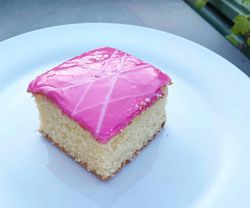An iconic London dish, Tottenham cake was invented by Quakers who lived in north London, having moved away from the distractions of the inner city. First sold by Quaker Henry Chalkley, from 1901, Tottenham cake was available for one old penny per cube, with smaller, misshapen offcuts available for half the price. What’s most notable about the cake is its lurid pink icing. A colour reminiscent of the Elephant & Castle Shopping Centre during the mid 1990s, the distinctive pink icing originated from mulberries being used in the icing, picked from the grounds of the Meeting House of the Tottenham Friends (Quakers) on Tottenham High Road.
As well as being accessibly priced, Tottenham Cake reflects typical Quaker values of simplicity and equality in some ways. The cake requires just a small amount of ingredients, baked in trays which makes it easy to cut into many portions, to be shared. When Tottenham Hotspur Football Club won the FA Cup for the first time, also in 1901, the cake was even distributed to local children for free, in celebration of the Spurs’ historic win.
Once considered “a peculiar invention” of north London, Tottenham cake is now available nationwide, still made by local Quakers, plus national high street bakery chains. Of the readily available options, Percy Ingle’s Tottenham cake recipe was arguably the best, and certainly the most famous. After 66 years of serving London and Essex communities, the bakery has closed its entire network of bakeries over the past year, taking their beloved baked goods away from the high streets. Another devastating blow in working class London’s fight against gentrification.
Celebrating the Percy Ingle version with its lurid pink icing, this straightforward Tottenham Cake recipe bakes in just 35 minutes, featuring sponge spiked with orange zest and vanilla extract. The icing, on the other hand, uses traditional mulberries, but raspberries can be used as a more than worthy substitute if mulberries are unavailable.

Tottenham Cake
Equipment
- 30 x 20cm baking tin
- Electric mixer (optional, but useful)
Ingredients
- 300 g self-raising flour
- 2 tsp baking powder
- 4 medium eggs
- 225 g unsalted butter
- 225 g caster sugar
- 1 tsp vanilla extract
- 1 orange zest only
- 3 tbsp milk plus extra, if needed
- 120 g mulberries or raspberries
- 300-350 g icing sugar
Instructions
- Preheat the oven to 180°C/Gas 4.
- Grease and line a 30 × 20cm baking tin with greaseproof paper.
- Ideally using an electric mixer (but a wooden spoon will do, if need be), mix the butter and sugar until creamed.
- Add the eggs, one at a time, and mix to combine. Stir in the vanilla extract and orange zest, then fold in the flour and baking powder. If the cake batter is too thick, add the milk one tablespoon at a time and mix.
- Transfer the cake batter to the baking tray and bake for 30-35 minutes, until a cocktail stick inserted into the centre comes out clean. Leave to cool in the tin.
- While cooling, heat the mulberries or raspberries with 2-3 tablespoons of water until soft. This will take around five minutes. Once soft, pass through a sieve into a clean mixing bowl, using the back of a spoon to squeeze out as much juice as possible. You should have around 5 tablespoons of liquid. Add a little cold water if necessary.
- Add the icing sugar, one tablespoon at a time, and whisk. Start with 300 grams, but if the icing is too thin, add another 50 grams or so until the consistency is correct. It should resemble smooth wallpaper paste.
- Gently remove the cooled cake from the baking tray and spoon the icing over the top. Smooth using a palette knife and leave to set. Once set, cut the cake into squares and serve.

